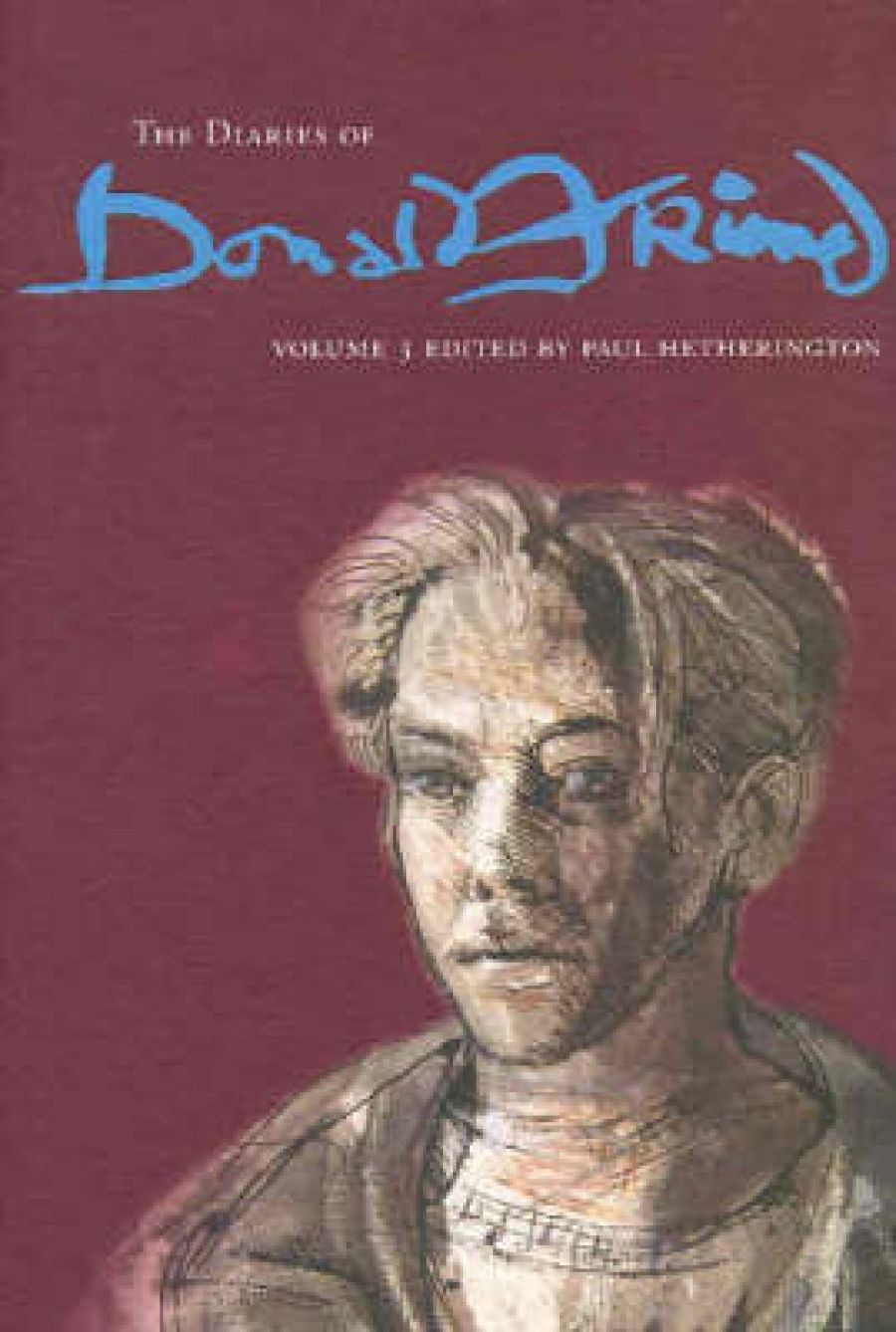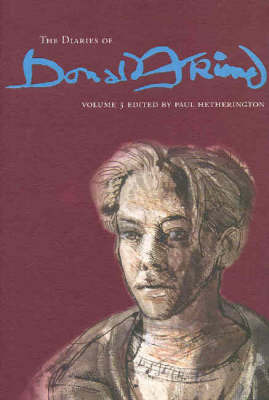
- Free Article: No
- Contents Category: Diaries
- Review Article: Yes
- Article Title: The brilliant fabricator
- Online Only: No
- Custom Highlight Text:
With the greatest novels, you can plunge into them anywhere and still savour their greatness; it is recognisable on every page. You won’t need to have read the two earlier volumes of these edited diaries to recognise that same quality throughout the third – and I mean novelistic greatness, of which all the great diaries (from Samuel Pepys’s to James Lees-Milne’s) partake in important ways.
- Book 1 Title: The Diaries of Donald Friend, Volume 3
- Book 1 Biblio: NLA, $59.95 hb, 712 pp
- Book 1 Cover Small (400 x 600):

- Book 1 Cover (800 x 1200):

Greatness in this respect is partly a matter of range or scope; books possessed of that quality, however specific their titles or restricted their settings, prove to be about pretty well everything under the sun and often including the kitchen sink. Compare War and Peace and Pride and Prejudice: their respective emphases and scale are obviously different, but to neither of the authors of these works are world-historical events, individual human passions and domestic minutiae ever above or beneath their consideration, let alone beyond their imaginative capacities to recreate in vividly suggestive ways. Donald Friend’s diaries are packed with richly evocative vignettes of war and peace, pride and prejudice, and a whole range of other public concerns or private emotions as they pertain to himself or those he observes throughout most of his life (in this volume from 1949, when he had just turned thirty-four, to 1966, on the eve of his fifty-second birthday).
As one of Australia’s most celebrated artists of the day, Friend might have been expected to concentrate on the contemporary art scene and its other leading figures; and, sure, we are treated here to many deft, wry, sharp, succinct summations of fellow painters, from Russell (‘Tas’) Drysdale, one of his oldest friends, to new wunderkinder on the block, such as Brett Whiteley. There are also some penetratingly respectful or witheringly dismissive accounts of dealers, models, patrons, gallery groupies and art critics (including another wunderkind, Robert Hughes, who in 1965 chose Friend as the subject of his dazzling publishing début). But Friend’s gaze is all-encompassing, promiscuous in the broader, as well as the narrower, sexual sense, and his recording instinct compulsively catholic and democratic: the most menial of tradesmen and servants (and not just his kept – or not so easily kept – boys) can earn as detailed attention from him, affectionate or scathing and sometimes both at once, as the millionaire businessmen, suave diplomats and glamorous socialites who also cross his daily path. Human complexity, however ordinary or extraordinary the talents of the individuals concerned, is an abiding motif in these pages. And he’s as apt to read the multilayered human world around him in expressly novelistic terms (‘Proustian’, ‘Firbankian’) as through the eyes of favourite painters, such as Bosch or Tiepolo.
The omnivorous compulsions on display in these diaries are clearly an associated symptom of what drives him as a painter, and in whichever more or less exotic location we find him in this particular volume (Italy, London, Sydney, his beloved cottage at Hill End in New South Wales, far north Queensland, Ceylon), the studio or its makeshift equivalent forms a ubiquitous backdrop. But so do the garden, where he can labour zealously with his own hands, and the kitchen – at the stove, if not quite the sink. When the painting muse deserts him on one occasion, he happily confesses to devoting ‘more time and ingenuity to … cooking’ and to gaining a greater sense of satisfaction from this. On another occasion, observing his ‘adopted’ family in the Torres Strait, the Sailors, he sees no need to discriminate between the ‘classical dignity’ of their unsung daily labours and that exemplified by ‘great art’.
The greatness of great literary art is only partly a matter of the range of human behaviour that it is capable of capturing and representing; this needs to be married with, so as to appear inseparable from, an appropriate mode or style of representation. Friend puts it less clumsily when he ascribes to his favourite kinds of novel, ‘a style which can enfold past and present, dream, fancy, fact, satire, folklore, all easily lying together without boundaries’. Though he doesn’t intend it as such, this is as crisp a summary as we might find of his own accomplishments as a diarist. The diary form lends itself to such a free, ‘picaresque’ mode ¾ a style of life as well as a style of literature that Friend also explicitly commends at various points. The only boundaries of the form are chronological ones, though the otherwise inescapable plod through linear time allows for all manner of ruminative rambles into the past along the way. (A week of breakfast feasting on honey from a comb, which Friend records on 16 January 1955, prompts a very Proustian cadenza on ‘the remembered porridgy smell of the nursery’ in his childhood nearly forty years earlier.) And while there may be a far higher proportion of ‘real-life’ characters in a diary than in a regular novel, there’s no more obligation on the diarist than on the novelist – or the painter – to stick to what Friend calls at one point ‘the unsatisfactory skin of visible facts’.
The distinctive triumph of the Friend diaries, in their original manuscript form, is the way they palpably break down the boundaries between the writer and the painter, the visual and the verbal artist. For throughout great stretches of them, the confidently handwritten text (with its blots here and there, but few crossings-out) is accompanied by, sometimes inscribed onto, a ravishing succession of drawings and sketches of the people, buildings, landscapes and artifacts being described. Many of these illustrations, if that word is sufficient to convey their ‘organic’ connection to the narrative, are in ebullient colour. If I have any reservation about the edited volumes to date (aside from minor concerns over a few possible mis-transcriptions in the printed text or missed allusions in the otherwise extremely helpful endnotes), it is that they don’t sufficiently register this triumphant achievement. There is something a bit chaste, lapidary, about their format. At least this third volume represents a marked improvement in this respect, with more of a sense conveyed of the original through a few colour reproductions of its luminous, animated pages. But not enough of a sense, clearly, to dispel the curious logic of the blurb-writer – no less an authority than Robert Hughes – when he says of Friend and his diaries that ‘though he was such a gifted artist, I think they are his real masterpiece’ (emphasis mine).
Maybe nothing short of a facsimile edition could convey the full achievement of this meta-diary, this prototypical ‘graphic novel’. And who today could afford to produce or purchase such an item? Until future technologies provide the means for such, we should remain very grateful to the National Library for finding a practical way of making one of its archival jewels common property, and for giving many more of us than before the opportunity of sharing the company of its brilliant fabricator.


Comments powered by CComment